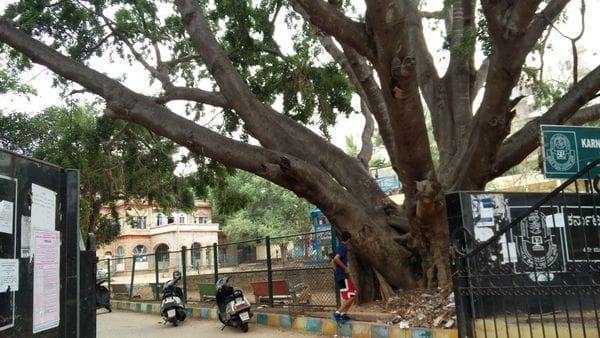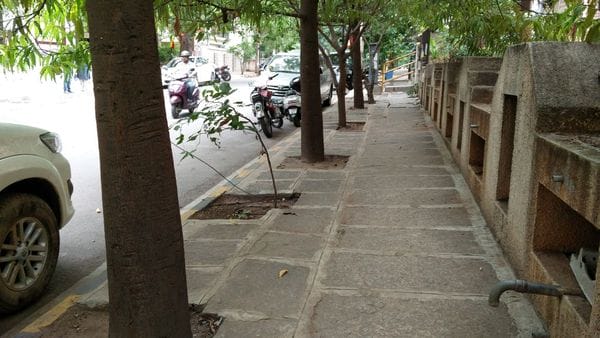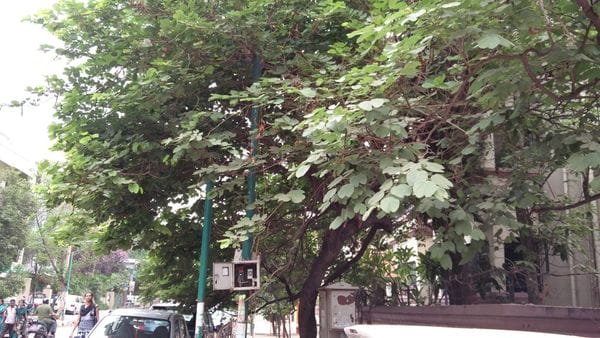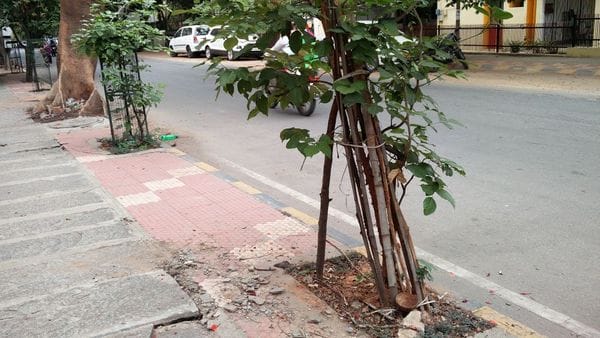
A huge tree inside the Government high school compound in Malleshwaram. Pic: Shree D N
Sanjeev is a musician by hobby and a researcher at Indian Institute of Science, that is full of variety of trees, but he knows the rest of Bengaluru is not a match to his campus and more trees need to be planted everywhere.
Amogh Sharma is a native Bengalurean, now working in Chennai. He visits Bengaluru every weekend and feels Bengaluru needs more trees, but does not know what needs to be done for that to happen.
Ajay is an engineer working in Bengaluru who travels on Outer Ring Road everyday, and feels bad about the barren tree-less roads.
These three, and many others in the city, have a common problem: they don’t know where to start. This article is a guide for all those who want to start tree-planting this season, in Bengaluru. First of all, answers to some commonly asked questions and problems.
Rains will arrive in June. Why should trees be planted in May?
In fact, saplings should be planted not in May, but in April. The planted saplings should be watered manually till the rains. By doing this, the plants will survive the planting shock and the summer heat, and be ready to greet the rain. During rainy season the saplings can grow fast, to become self sufficient and will need less care to sustain. Also for some reason if some sapling doesn’t survive, you can plant another sapling in that place during rains.
I don’t know where I can plant trees.
Places where people can plant saplings are:
- Their own home/apartment compounds
- Public places (parks, open spaces, street footpaths, street medians, lake sides, forests etc – any government-owned space)
However, in each of these places, permission is required to plant the saplings. BBMP, BDA, Forest Department, Lake Development Authority etc own these places, and they have to be approached for tree planting permissions.
Other things to look for are:
- If it is footpath, is there enough space to walk around the location identified? If not, the tree on narrow footpath is likely to be cut on a future date to avoid inconvenience.
- Are there overhead electric/ telephone cables? If there are, they need to be organised in later years so that they don’t affect the growing tree. Generally there will be cables dangling over all footpaths, so planting beneath them need not be avoided but enough care needs to be taken so that they do not affect each other.
- What are the underground utilities that might be lying beneath the identified surface? The roots might meddle with the underground cables, sewage system or water supply if they are damaged or old. In Malleshwaram, an old BWSSB water line was penetrated by roots of a huge tree a few years ago, and the water line had to be changed and tree had to be cut.
- What type of land have you identified? Is it footpath tiles, granite slabs, concrete, asphalt or pure mud? Tiles and slabs will need removal before digging the pit. Concrete will be difficult to dig. Asphalt can be dug with some effort, but if the space is part of the road, remember that the sapling you plant will reduce the road width causing traffic jams in future, or will just get mowed down by vehicles.
- Has the road or area where you are planting been marked for widening or other purpose? Bengaluru does not have a tree replanting plan, so avoid planting saplings on roads or areas marked for widening or installation of skywalks or construction of buildings. Local BBMP officials will know all such plans, talking to them will help.
Basavana Pada is a tree that is overplanted in some areas such as Malleshwaram. Pic: Shree D N
I don’t know how many trees a place can hold, and what to plant where.
Ideally, there should be a space of 15 feet between two saplings that will grow big, else as they grow one will interfere with another and there will be problems of cross pollination, fight for resources like water and nutrients etc.
There are many theories on what to plant where. It really depends on the core reason why we are planting the saplings. Key thing to keep in mind is
- Do not go for foreign varieties of trees that are not native to Bangalore
- Promote local and organic varieties. (Bengaluru has lost biodiversity, with mass afforestation measures focusing only on certain species in certain areas. For example, you will find more Honge (Pongamia Pinnata) and Basavana Pada (Phanera variegata) in Malleshwaram. Variety among trees planted is required to ensure biodiversity, because naturally various plants attract various types of insects, birds, bees and animals, and all of them have different uses.)
- Know the source of your sapling. Go to trustworthy sapling providers. No GM saplings, or hybrids that do not survive beyond a generation.
- Get more fruiting and flowering varieties, rather than focusing on just greenery and shade.
- Get a sapling that is at least three feet high. Younger the sapling, difficult for it to survive the replanting shock where the sapling is shifted from the controlled environment of a nursery in the soil placed in a pot or a plastic bag, to huge open environment with no real control over what might lie in the soil.
- Go for species with taproot system that go deep down in the soil and straight up in the sky rather than spreading, in commercial areas that have hoardings etc, because trees that spread across are likely to be cut by hoarding owners to increase visibility of the hoardings.

Spacing between two trees needs to be of about 15 feet. Pic: Shree D N
This guide published by us two years ago gives you a great idea about the species that you can plant, depending on various locations. This list shared by Ganesh Ram, a botany enthusiast who is a part of Artyplantz lists some of the native trees and the benefit from them for flora and fauna. And here’s a teasure trove of details on flowering trees with photos, compiled by S Kartikeyan, the blogger at wildwanderer.com.
What are the expenses involved?
- Cost of the sapling: This can be minimised by networking with likeminded people and figuring the cost across all nurseries, transport cost etc and planning wisely. You will know the tricks tricks and trades once you get into it. You can also have interested people to donate saplings/ bear the cost of saplings.
- Cost of the tree guard: Metal tree guards and bamboo tree guards are the commonly used ones. Bamboo tree guards cost less – the cost really depends on how you get them. You can get readymade ones, or get bamboo from bamboo bazar in Bengaluru and use iron wires to tie them together after planting. A plant will need four poles of bamboo that are 1.5 meters in height. These are temporary and are biodegradable.
Metal guards cost more (Rs 1100-Rs 1500) but are permanent and can be reused on many trees for many years. If you are planting inside a gated community or a residential area it’s safe to use metal guards. - Cost of manual labour/ JCB used to dig pits: Kavita Reddy of HaSiRu Mitra recommends digging holes using JCB, because more work gets done in less time. Manual digging is labour-intensive and can cost more. Whatever mode it is, be watchful for any underground cables, sewage or water lines before digging.
- Cost of red earth and compost if required: This also depends on where you source it. There are many apartment communities that might be happy to give away the compost that they prepare. Good soil can be sourced by asking nurseries or farmers around Bengaluru. A lot of it depends on your connections.
- Cost of watering the saplings till the time they can sustain on their own: Easiest way to minimise this cost is to request the local community- a house, an apartment or a shop- to take care of the sapling and take ownership. This will also ensure that the tree is loved by locals and can survive for a long time. In large public places like parks, there will be water generally. If not, water needs to be supplied using tankers. Places where nobody takes ownership, such as Outer Ring road or a secluded area need special care. Here too using treated water etc will help minimise cost.
Metal tree guards are longer lasting. Bamboo ones serve the purpose, but they degrade fast. Pic: Shree D N
I get all this. Yet I don’t know how to get started!
Here you go, step by step.
- Identify locations where you want to plant trees.
- Take permissions from the concerned, if it is private property, take permission from the owner. If it is BDA property take permission from BDA, if BBMP, take permission from BBMP.
- Plan what to plant where. Decide the number of saplings for each variety you choose.
- There are three ways to get the actual planting done.
A) Organising it yourself
B) Getting it done by BBMP
C) Getting it done by NGOs
|
A) Do it yourself |
B) Get it done by BBMP (in BBMP limits) |
C) Get it done by NGOs |
|
Recommended for initiatives where you have less number of saplings |
Recommended for large streetside planting drive, or parks |
Recommended for large streetside planting drive, or parks or lakesides |
|
Take permission from the concerned persons / authority |
Identify the caretaker who will water the sapling till it can survive on its own |
Identify the caretaker who will water the sapling till it can survive on its own |
|
Identify the caretaker who will water the sapling till it can survive on its own |
Work with the corporator and BBMP forest cell to get things done – permissions, saplings, tree guards, labour/ JCB etc. |
Give the locations to NGOs like Saytrees, Trees for free or HaSiRuMitra. Permissions will be taken care of by them. This saves the hassles of running around for permissions and funds, or wait for BBMP to float the tenders. |
|
Decide what kind of tree guard you want – metal or bamboo. Source the tree guards, saplings, soil, compost etc as required. Here is a list of some nurseries, compiled by Green Bengaluru team. |
Have someone from the community supervise the activities on identified stretches. Inform residents of the neighbourhood. about the planting drive. |
Inform residents of the area, about the planting drive, to avoid taking them by surprise. |
|
Inform the people living near the area where you will be planting trees. Get labour to dig the pit / dig it yourself if you have the equipment. Plant the saplings. |
Actual planting drive – getting saplings, getting pits dug up, getting soil and compost, planting – all done by BBMP along with citizen supervision |
Actual planting drive – getting saplings, getting pits dug up, getting soil and compost, plantng – all done by identified NGO along with citizen participation. |
|
All funds will be arranged by you and your supporters. |
BBMP funds will be used. |
CSR funds will be used by NGO |
|
Have people identified take ownership of the saplings planted/ take care of the yourself. Water them till it starts raining, and when you feel the sapling needs water. |
Have people identified take ownership of the saplings planted/ take care of the yourself. Water them till it starts raining, and when you feel the sapling needs water. |
Have people identified take ownership of the saplings planted/ take care of the yourself. Water them till it starts raining, and when you feel the sapling needs water. |
If you know more suppliers of any resources like saplings, tree guards, NGOs that are into tree planting etc, please comment below this article, we will add them to the lists we have.
How should the tree be protected?
- Do not let anyone get the areas around a tree asphalted.
- The design around the sapling should let water percolate into the land. Putting clay tiles with spacing in between will be a good idea.
- The boundary around the sapling should be clearly demarcated by some visible means, to stop people from encroaching it or using the space for parking.
- Tree guards will help in protecting the trees from animals like cows and donkeys. They will also act like visible barriers that will stop people from mowing down the plants.
- Prune the branches of the tree regularly every three months, to stop extra branches from shooting below eight feet eight, so that it doesn’t obstruct the movements of people and materials, which sometimes becomes a reason for tree-cutting.
Key things to remember while getting into treeplanting:
- There may be people who don’t want trees in front of their houses. You need to convince such people before planting there. Else it will be a waste of time and money.
- Trees too need nourishment. In urban set ups people generally forget about this even when they see the trees all the time. Good water seepage area around the plant and some nourishment in the form of compost/ liquid compost will make the trees healthy and less susceptible to untimely breakage of branches or the tree itself.
- Any tree might fall during rains. Particular species of trees like Basavana Paada, Jacaranda and Raintree are susceptible to falling. But it should not discourage one from planting a tree. Understand what species are strong generally, and go for such species.
- Any tree will have a certain lifetime particularly in a city, after which it will be either cut by someone, or will fall on its own. Key is to not fret over fallen trees and get discouraged but to plant new saplings wherever you can, because every bit of greenery matters.
- Do not expect all the saplings you plant to survive. Keep monitoring along with nurturing. Replace the dead saplings.
- Adding some amount of cocopeat to the compost you add to the soil for planting the sapling will help in retaining water for a long time, because cocopeat is a water retainer.
What to do with cut tree-trunks?
You see a huge tree being cut down for whatever reason, and the area earlier covered by shade now looks boring. The tree trunk is still left there on the roadside. There can be a tree planted there, but the removal of tree truck will require a lot of work, including digging the road, as the part beneath the surface will be huge with roots spread all across. In many areas, people tend to burn it. What can be done with this?

Saplings can be planted on tree trunks too. Pic: Shree D N
In this case, your job of planting a sapling there is super-easy. You just need to drill a 2-ft deep hole in the centre of the remnant of the dead tree, and put the sapling and close it with soil and compost. Then water it till you see the sapling thrive. The dead organic matter around the sapling will act as a good sink for water and nutrients, and will help the sapling for a long time.
Caveat: This can be done only if the BBMP gives permission, because if there is a larger purpose like road widening or installation of skywalks behind the tree cutting, there is no use planting a tree because it will be cut again.
Finally, if you are a tree planting enthusiast, join this citizens’ group: Green Bengaluru

